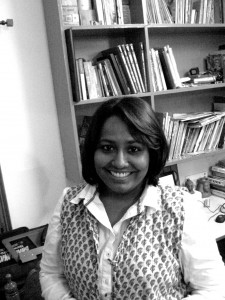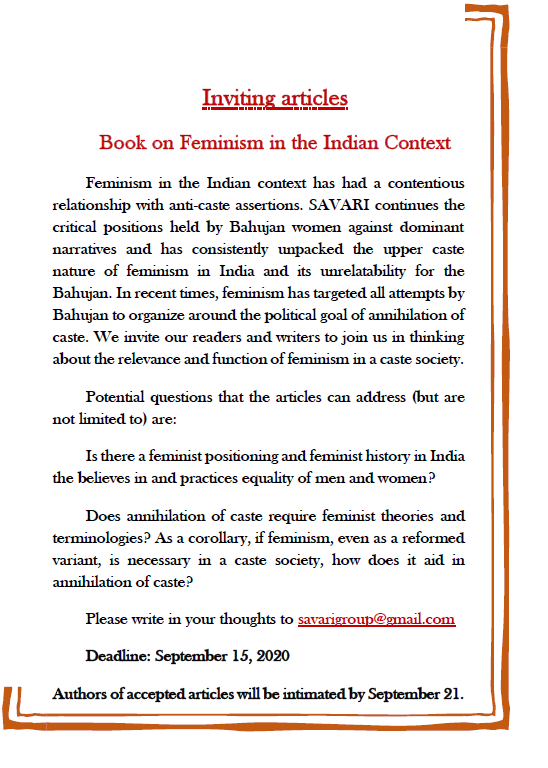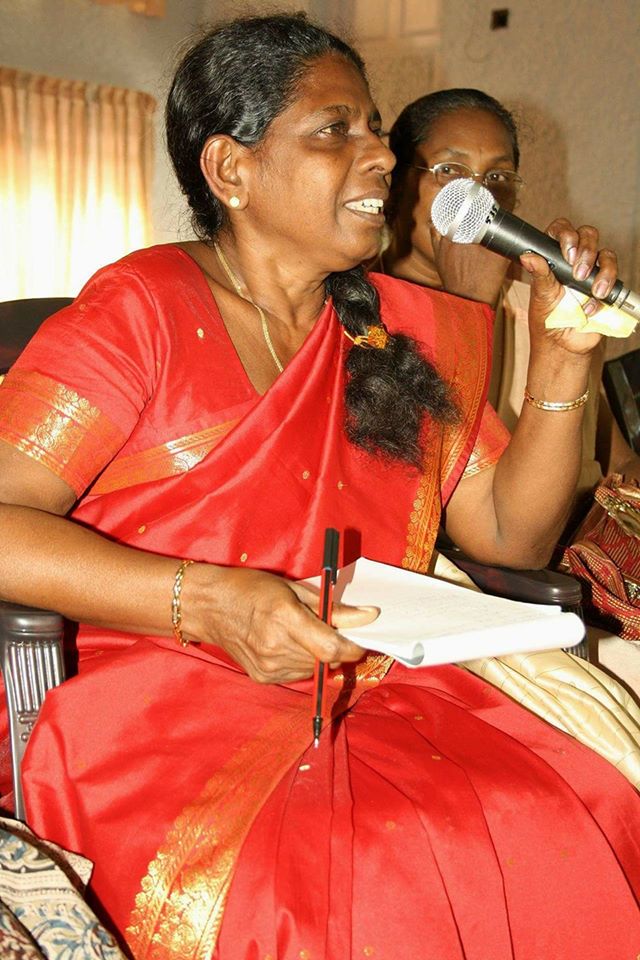Jyotsna Siddharth
 Today’s status quo bites me. The upper-caste, upper class, elitism in feminism, the hypocritical pretension about issues and a bit of everything is disturbing. I would not have come up with this piece if I did not have the opportunity to attend an event recently in Delhi and would like to thank Zubaan for such a thought provoking event that gave me a push to reflect on contemporary feminist politics and where it’s heading.
Today’s status quo bites me. The upper-caste, upper class, elitism in feminism, the hypocritical pretension about issues and a bit of everything is disturbing. I would not have come up with this piece if I did not have the opportunity to attend an event recently in Delhi and would like to thank Zubaan for such a thought provoking event that gave me a push to reflect on contemporary feminist politics and where it’s heading.
The event was part of a series called Zubaan Talkies, the specific instalment ‘Take 5: Why did the Feminist Cross the road?’ held at The Attic in Connaught Place. I went there for two reasons: a) firstly I wanted to talk about the cartoon that was imprinted on their invite which I found anti-feminist and trivialising a serious issue b) and secondly for the simple fact that it was a Zubaan event and I wanted to see what happens there. I also wanted to know why the feminist crossed the road, as there were many old flavours of the feminist movement still present with some new emerging feminists trying to build their space in the movement. Not expecting to have received a fixed, final response, I was disappointed that it failed to provide any thought-provoking responses.

Courtesy: Zubaan
To begin with, the cartoon depicts a naked woman sitting on top of a naked man who is lying, uninterested in her, on the bed and reading a newspaper. One can see two thought bubbles around the woman saying “All right I am on top” and another one says “Now what”! What the hell does the cartoon signify? The woman on top looks quite exasperated while her partner is least concerned, engrossed in a newspaper. What does it tell us about feminist politics? One reading of the cartoon could be that women only care to be on top and it doesn’t matter what follows, which is far from being a feminist reading. Another reading could be that now that she has conquered the top position she does not know what to do, which is silly. And finally, it trivialises a certain moment in the history of Western feminism when women were making a claim on their bodies and on sexual pleasure and on demanding sexual positions different from the missionary one which this cartoon was mocking.
Nevertheless significant number of people turned up and none of them appeared to have a problem with the cartoon. The talkies began with an advertisement of Fair and Lovely where it was shown that a priest with his dark-skinned daughter enters a modern beauty company thinking it to be a temple. Once they figure they are at the wrong place, they start to move out and at that moment the woman at the reception says, “Aise Ladkiyon ko sundar banana hai to Vedo ke zamane mein nahi reh sakte.” The father being hurt, goes back to his house and digs into his treasure box of herbs. He finally comes up with a solution that transforms his daughter into a “fairy” (who is obviously white, have you ever seen a dark fairy!!). They discussed the hierarchy within complexions and that ‘white’ is the ultimate desired skin colour. Aren’t we already aware that India is a racist, sexist, casteist, classist, homophobic country? So why are we so surprised at the ridiculousness of Fair and Lovely? The point here is not the advertisement that most of us have grown watching since childhood. The point is: how long are we going to base our discussions on old schools? Have we run out of issues to ponder on? Are we clueless about which direction to head?
This is not to say we do not need critical analysis of media texts. There is a serious need to be critical about everything we watch on television from news to movies, commercials to songs, cartoons to reality shows. However, one observes a lack of conviction to place it in the contexts of marginalised. Why are caste concerns not pictured in these fancy events? Why does talking about caste make us so uncomfortable, especially in these glamorous, elite events where no one wants to bring up any insight remotely linked to caste? It seems like we are already living in a dream world where you leave caste at the doorstep the moment you step into an air-conditioned mall, a fancy restaurant or elite discussion tables!
In fact, caste, class and gender privilege do not only get reflected in the kind of clothes we wear but the ones we don’t, not only in the vocabulary we use but the vocabulary we don’t or the food we will not eat due to our position in a particular caste. Thus, it looks cool to appear a certain kind, speak a certain kind of language, and live in the ‘ideal’ world where caste is non-existent. We talk about all issues from poverty to special economic zones, history to geography — why not caste, class, privilege? Why have we repeatedly failed to talk about caste complexities? It definitely says something about our position with respect to the existing caste system in India. As the gravity of caste affects all of us in different ways, why its eradication is considered the “liability” of the marginalised alone? After all, the push needs to be from both ends to mitigate the disease that has corrupted our society for many generations. I wonder whether it is ever going to happen if the “resourceful, educated and political mass” fails to prioritise the issues of caste, class and gender privilege.
Zubaan’s feminist conception and practice is highly problematic where it is glamorous to talk about only body and sex without understanding the nuances and its intertwined nature with other significant issues of caste discrimination, homelessness, violence, poverty and conflict situations. Zubaan clearly targets only the upper class and upper caste in Delhi and that is shameful for a so-called feminist press.
Zubaan being the oldest feminist publication house has published several interesting books on women’s issues in the past and continues to do so. It is a platform which caters to and is quite popular amongst the intelligentsia from all over the country and abroad. It is a publication house people look up to and regularly follow. It is, therefore, disturbing to see that such a feminist publication house which has a significant fan following and supports an ideology fails to bring in caste, class and gender privilege into their regular discussions.
The stand ups done by Anita Roy and Gautam Bhan were flat and uninteresting except to a highly privileged and South Delhi in-crowd. The stand up by Anita Roy gets ten on ten on confidence, choice of words and style of performance. However, I could not relate with the “humour.” To be able to talk about one’s orgasm, favourite position in bed, and what would one prefer in bed is elitist. This is from the position of a large section of women, where I hail from, who fail to exercise “choice” in terms of whom they want to have sex with and do not. Along with being overworked, having persistently high levels of daily stresses and anxiety, sex is an additional source of stress. Orgasm is a failed reality for them, as most Dalit women are never asked if they are satisfied. Where they lie cold and wait for it to be finished. Repeatedly upper-caste men and their Dalit male counterparts have treated them as sex machines and it is but obvious that a machine does not have a say in how it will be used. Dalit men are as insensitive in bed as any other men, if not worse.
Official Indian crime statistics, averaged over the period 2001-2005, recorded: 27 atrocities against Dalits every day, 13 Dalits murdered every week, 5 Dalits’ homes or possessions burnt every week, 6 Dalits kidnapped or abducted every week, 3 Dalit women raped every day, 11 Dalits beaten every day, a crime committed against a Dalit every 18 minutes. It makes me extremely uncomfortable and helpless to feel that a Dalit women might be getting raped in some part of the country while we are talking orgasms.
As a dark-skinned, Dalit woman, I found some jokes to be not funny at all and some highly objectionable. The joke about people living in West Delhi, for example, played on the stereotype which immediately put South Delhi on a higher plane than the rest of the city. I had a problem because a) calling people from a certain part of the city inferior than South Delhites is not funny b) I find it difficult that anyone finds humour in such stereotypes which only lay bare class and caste biases.
The danger of today’s urban world and its so-called feminism is its complete shamelessness about its own class, caste and gender privilege. It is easier, rather convenient, to fall into a trap of conformism and conservatism. There is a need for constant self-interrogation. It is important to be conscious of one’s politics drawn from serious empirical engagement and strong theoretical grounding and Zubaan’s politics has neither. Politics coming from the air without an active engagement with either field or theory only obfuscates issues and dissolves in mindless upper class and upper caste titter.
The host thanked everyone for coming to the event and for laughing. Nevertheless, the event concluded with laughs! Were we laughing at ourselves or at others, I went home wondering as Zubaan, fittingly, did not leave any time for discussions or questions!
Jyotsna Siddharth: I am a postgraduate in Development Studies from Tata Institute of Social Sciences. Currently I am working as a gender consultant with Ministry of Rural Development. I am interested in learning about Caste, Feminism, Philosophy, Literature and Poetry.
This article is also published at Round Table India


I loved your article. You locate feminist and queer narratives within frames of privilege which is the direction that you would like to see our critical thinking pushed. Indebted to your thought really! I now know why I like people from TISS. Such original thinking that unveils our own prejudice which goes beyond language to even silly jokes. This is absolutely great! Thanks.
Thank You 🙂
I do like the argument, that while a certain section has been debating on women’s bodies and sexuality, there is a lack of concern when it comes to the body of a dalit woman. The notion of honor, sacredness, protection and control, which a upper caste woman might face, is somehow neglected when it comes to dalit women. So while breaking the shackles of oppression means the right to orgasm perhaps, the notion of freedom for dalit woman is the right not be humiliated and not to be violated first and foremost. Maybe we could think about orgasms after we have gained respect for our bodies and earned respect enough to think of pleasuring it.
You’re right that the event could have taken a broader perspective, but isn’t that true for any event? Zubaan’s event was a light-hearted exploration of a relatively taboo topic; I’m sure it came as news to a lot of desis that women have orgasms. The fact that the event was focused on women who’ve begun to take pleasure in pleasure doesn’t imply Zubaan is elitist or is indifferent to women, Dalit or otherwise, who have other concerns. I suggest it implies there’s a need for more events that complement Zubaan’s event. An insistence of representation often degenerates into tokenism. After all, there are plenty of other neglected groups: south-Indian women, Indian Christian women, North-east women, Muslim women, handicapped women, single women, childless women….
Secondly, isn’t a Dalit woman, a woman? Aren’t there upper-class Dalit women with the same concerns as other upper-class women? Her being Dalit may be a defining feature, but surely it cannot be the sole defining feature. Was there an effort to make it clear that the women being portrayed couldn’t be Dalit, or was it something inferred on the basis on color, accent, class-status? What we have is one small brave organization that took up one small brave issue. There is much more to be done, but what (also) needs to be done can build on the good that has been done. It needn’t be a zero-sum game.
I guess I’m saying Zubaan is part of the solution, not the problem, and to make them part of the problem is to hurt the larger cause of women’s rights. That said, I’m glad you called Zubaan out on its perhaps overly-narrow focus (I wasn’t there). And in the interest of disclosure, I must report I’ve worked with Zubaan, am working with them, love what they do, so bias must be taken as a given.
Thank you Anil for sharing your thoughts. Your response somewhere takes us back to the critique of western white feminism by black women emphasising that not all women are equal. There are disparities in the oppression that women face due to thier location in a particular caste, community, religion and class. I am not trying to argue that dalit woman is not a woman, offcourse but her reality is way different from an upper-caste woman, so is the reality of a muslim woman than a non-muslim and i hope you’ll agree wid me here. I dont hold anything personal against Zubaan but my article was a small effort to bring the dialogue around caste in feminist politics which rarely gets highlighted. I was a great admirer of Zubaan’s work and still is in some way but I deeply feel that being the first and premier feminist publication house with such massive fan following should become even more vigilant and open about their politics. Who says caste doesnt play a role in upper-caste lives? offcourse intensity may vary, issues may vary but living in India can we disregard the importance of caste in our lives is my question?
Dear Jyotsna
Hi
I absolutely agree with you that a women’s sexual choices cannot be ridiculed in the manner that the cartoon does and am happy that you have written on it. Caste has always played the most important role in the choice of partners, arrangements at work and pervading discrimination in all arenas of personal life in India. Its the most uncomfortable part of the Indian psyche and women especially upper caste women find it very difficult to interrogate it. Often when I as feminist activist have brought in caste and gender in my discourses I have been told ” You have to be a Dalit woman to understand Dalit realities, otherwise you cannot really articulate Dalit women’s issues” where then my caste became the issue and not the community based violence against Dalit women, or denial of land rights or discriminatory work that they do. Also like upper caste feminist articulations and engagements there are tensions and debates on sexuality, religion and gender and such others among Dalit movements (note the plural) in India. I believe that we have to always in our engagements bring out our own thoughts and views which differ and are more nuanced in all such forums where we go to. Thats our ‘voice’ and no matter what, we will have to say it…….That’s what will make the difference……..
All the Best
Shewli, TISS
Thank you mam for your reflections. I completely agree with you that many times due to one’ position in “upper caste” one is asked to shut up on issues of caste. Change cannot be brought about by marginalised alone. However, I believe that there is a need to open the dialogue around the caste in all sections of society. We need ally, supporters and people ready to share power, only then we can think about social change.
Hi, I am doing a PhD on UP politics, more specifically looking at the extent to which the last BSP’s government urban housing and slum development policies succeeded in combating the marginalisation of the urban poor, in the particular Dalit poor. I found your post very interesting on a number of levels. The first thing that came to mind when about that Fair and Lovely ad was the caste connotations of the dark daughter of the priest changing her skin tone. So you are spot on when you say that not even mentioning caste is a glaring omission. I have also noticed that when I talk about my PhD to many people (non-academics), the issue of caste discrimination always makes people uncomfortable. Class prejudice is considered acceptable by so many people while caste prejudice is considered “backward” and “un-modern”. Yet its amazing how little think about the overlap and intersection between the two. Just the other day a Lucknow native told me that she didn’t like Mayawati for not doing anything for Dalits. Then in the next breath she said that Mayawati had made it too easy for “illiterate village people” to come to Lucknow to be exploited as vote-banks. When I pointed out the contradiction in her two statements, she didn’t even understand what I meant- she reproduced caste prejudice so unconsciously, while denying that she was casteist. Thanks for this post, its given me a lot of food for thought.